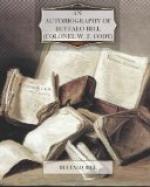But the love of adventure was in father’s blood. The railroad—the only one I had ever seen—extended as far as Port Byron, Illinois, just across the Mississippi. When the discovery of gold in California in 1849 set the whole country wild, this railroad began to bring the Argonauts, bound for the long overland wagon journey across the Plains. Naturally father caught the excitement. In 1850 he made a start, but it was abandoned—why I never knew. But after that he was not content with Iowa. In 1853 our farm and most of our goods and chattels were converted into money. And in 1854 we all set out for Kansas, which was soon to be opened for settlers as a Territory.
Two wagons carried our household goods. A carriage was provided for my mother and sisters. Father had a trading-wagon built, and stocked it with red blankets, beads, and other goods with which to tempt the Indians. My only brother had been killed by a fall from a horse, so I was second in command, and proud I was of the job.
My uncle Elijah kept a general store at Weston, Missouri, just across the Kansas line. He was a large exporter of hemp as well as a trader. Also he was a slave-owner.
Weston was our first objective. Father had determined to take up a claim in Kansas and to begin a new life in this stirring country. Had he foreseen the dreadful consequences to himself and to his family of this decision we might have remained in Iowa, in which case perhaps I might have grown up an Iowa farmer, though that now seems impossible.
Thirty days of a journey that was a constant delight to me brought us to Weston, where we left the freight-wagons and mother and my sisters in the care of my uncle.
To my great joy father took me with him on his first trip into Kansas—where he was to pick out his claim and incidentally to trade with the Indians from our wagon. I shall never forget the thrill that ran through me when father, pointing to the block-house at Fort Leavenworth, said:
“Son, you now see a real military fort for the first time in your life.” And a real fort it was. Cavalry—or dragoons as they called them then—were engaged in saber drill, their swords flashing in the sunlight. Artillery was rumbling over the parade ground. Infantry was marching and wheeling. About the Post were men dressed all in buckskin with coonskin caps or broad-brimmed slouch hats—real Westerners of whom I had dreamed. Indians of all sorts were loafing about—all friendly, but a new and different kind of Indians from any I had seen—Kickapoos, Possawatomies, Delawares, Choctaws, and other tribes, of which I had often heard. Everything I saw fascinated me.
These drills at the Fort were no fancy dress-parades. They meant business. A thousand miles to the west the Mormons were running things in Utah with a high hand. No one at Fort Leavenworth doubted that these very troops would soon be on their way to determine whether Brigham Young or the United States Government should be supreme there.




